Captive Portal Policy Web Page Configuration
Procedure
-
Select the
Web Page
tab to create locally or externally hosted HTML
pages.
The Login page displays by default
 Captive Portal Policy - Web Page - Internal Option Screen
Captive Portal Policy - Web Page - Internal Option Screen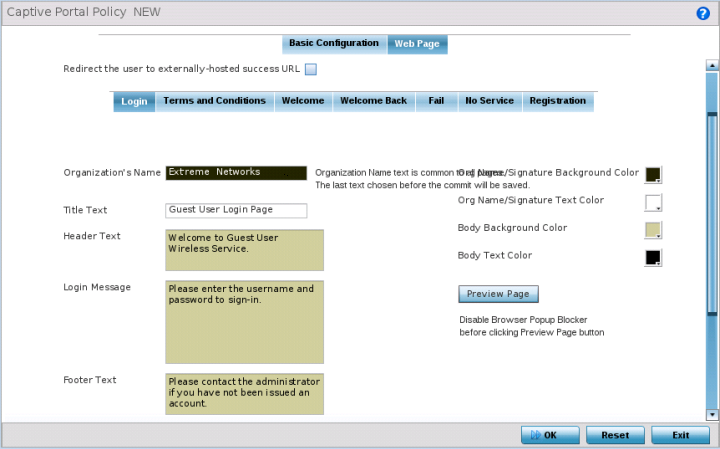
-
Refer to the following for information on the various
captive portal Web pages:
The Login screen prompts the user for a username and password to access the captive portal and proceed to either the Terms and Conditions page (if used) or the Welcome page.
The Terms and Conditions page provides conditions that must be agreed to before captive portal access is permitted.
The Welcome page asserts a user has logged in successfully and can access the captive portal.
The Welcome Back page greets returning users.
The Fail page asserts authentication attempt has failed, the user is not allowed to access the internet (using this captive portal) and must provide the correct login information again to access the internet.
The No Service page asserts the captive portal service is temporarily unavailable for technical reasons. Once the services become available, the captive portal user is automatically connected back to the services available through the captive portal.
-
Select the
location where the captive portal Login, Terms and
Conditions, Welcome, Fail, No Service and Registration Web
pages are hosted.
Available sources include Internal, External and Advanced. If Internal is selected, provide the information for each of the screens. If Advanced is selected, follow the on-screen instructions to upload custom Web pages. If Externally hosted is selected, provide the URLs for each of the necessary pages in the fields below.
Organization Name
Set any organizational specific name or identifier which clients see during login. This setting is available only for the Login page.
Title Text
Set the title text displayed on the pages when wireless clients access captive portal pages. The text should be in the form of a page title describing the respective function of each page and should be unique to each function.
Header Text
Provide header text unique to the function of each page.
Login Message
Specify a message containing unique instructions or information for the users who access the Login, Terms and Condition, Welcome, Fail, No Service or Registration pages. In the case of the Terms and Agreement page, the message can be the conditions requiring agreement before captive portal access is permitted.
Footer Text
Provide a footer message displayed on the bottom of each page. The footer text should be any concluding message unique to each page before accessing the next page in the succession of captive portal Web pages.
Main Logo URL
The Main Logo URL is the URL for the main logo image displayed on each of the pages. Use the Browse button to navigate to the location of the target file. Optionally select the Use as banner option to designate the selected main logo as the page‘s banner as well. The banner option is disabled by default.
Small Logo URL
The Small Logo URL is the URL for a small logo image displayed on the screens. Use the Browse button to navigate to the location of the target file.
Signature
Provide the copyright and legal signature associated with the usage of the captive portal and the usage of the organization name provided. This setting is available only for the Login page.
-
Refer to the
right side of each screen to define how the Org
Name/Signature Background Color, Org/Name
Signature Text Color, Body
Background Color and Body Text
Color display for current screen.
Select the box to the right of each of these four items to launch a color palette where screen colors can be selected uniquely. Select Preview Page to review your color selections before committing the updates to captive portal screens. Each of the Login, Terms and Conditions, Welcome, Fail, No Service and Registration screens can have their background and signature colors set uniquely.
 Captive Portal Policy - Web Page - Color Palette Menu
Captive Portal Policy - Web Page - Color Palette Menu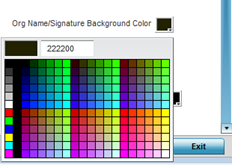
-
When setting
the properties of the Registration screen, refer to the bottom
portion of the screen to define email, country, gender,
mobile, zip, street and name filters used as additional
authentication criteria.
Guest users are redirected to the registration portal on association to the captive portal SSID. Users are displayed an internal (or) externally hosted registration page where the guest user must complete the registration process if not previously registered.
These fields are customizable to meet the needs of retailers providing guest access. The captive portal sends a message to the user (on the phone number or Email address provided at registration) containing an access code. The user inputs the access code and the captive portal verifies the code before returning the Welcome page and providing access. This allows a retailer to verify the phone number or Email address is correct and can be traced back to a specific individual. Captive Portal Policy - Web Page - Internal - Registration - Registration Page Fields Table
Captive Portal Policy - Web Page - Internal - Registration - Registration Page Fields Table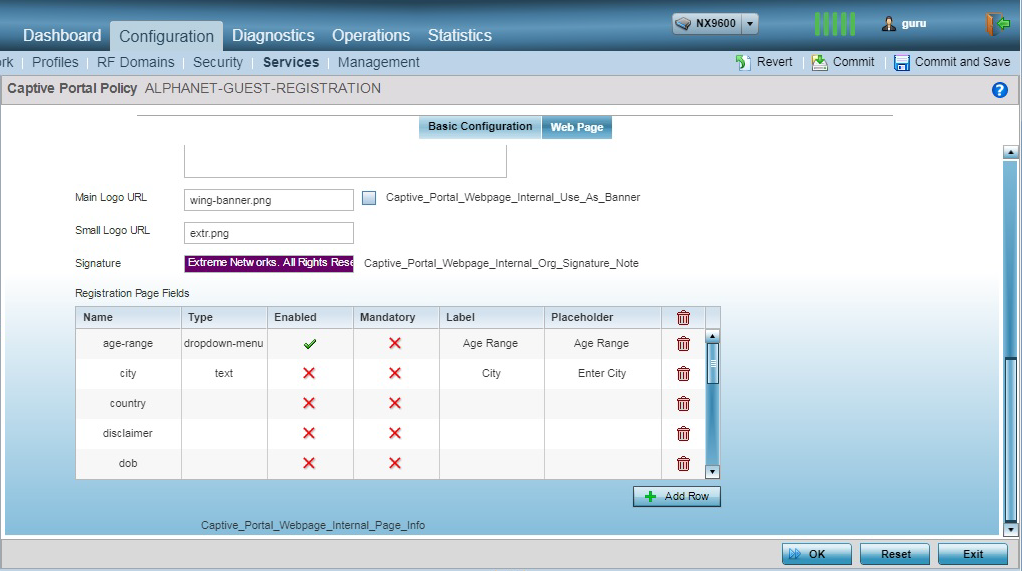
-
Click
OK to save the changes made within any of
the Internal Page screens.
Click Reset to revert to the last saved configuration.
-
If you are
hosting the captive portal on an external system, select the
Externally Hosted radio button.
 Captive Portal Policy Screen - Web Page Tab - Externally Hosted Web Page Screen
Captive Portal Policy Screen - Web Page Tab - Externally Hosted Web Page Screen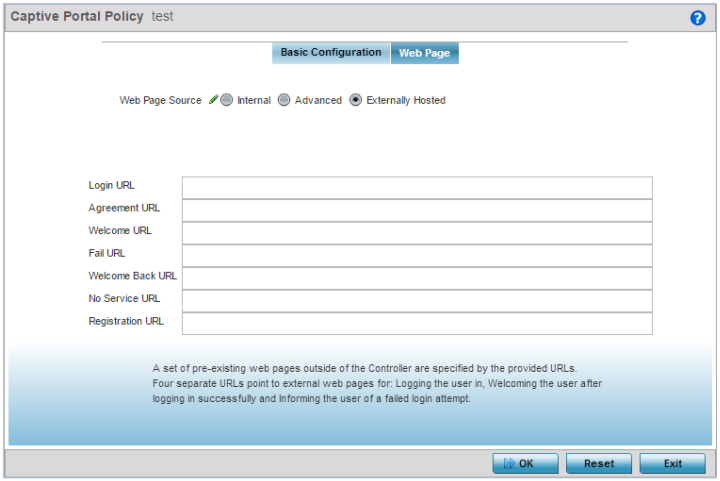
-
Set the
following URL destinations for externally hosted captive
portal pages:
Login URL
Define the complete URL for the location of the Login page. The Login screen prompts the user for a username and password to access the Terms and Conditions or Welcome page.
Agreement URL
Define the complete URL for the location of the Terms and Conditions page. The Terms and Conditions page provides conditions that must be agreed to before wireless client access is provided.
Welcome URL
Define the complete URL for the location of the Welcome page. The Welcome page asserts the user has logged in successfully and can access resources via the captive portal.
Fail URL
Define the complete URL for the location of the Fail page. The Fail page asserts authentication attempt has failed, and the client cannot access the captive portal and the client needs to provide correct login information to regain access.
Welcome Back URL
Define the complete URL for the location of the Welcome Back page. The Welcome Back page asserts the user has re-logged in successfully and can access resources via the captive portal.
No Service URL
Define the complete URL to the location of the No Service page. The No Service URL is needed by users encountering difficulties connecting to the external resource used to host the captive portal pages.
Registration URL
Define the complete URL to the location of the Registration page. The Registration page is displayed to new users to register (provide user information) in order to access the captive portal managed Internet resources.
-
Click
OK when completed to update the captive
portal policy settings.
Click Reset to revert to the last saved configuration.
-
Select
Advanced to use a custom-developed
directory of web pages.
Web pages in the directory can be copied to and from the access point, to support the captive portal.
 Captive Portal Policy - Web Page Screen - Advanced Option
Captive Portal Policy - Web Page Screen - Advanced Option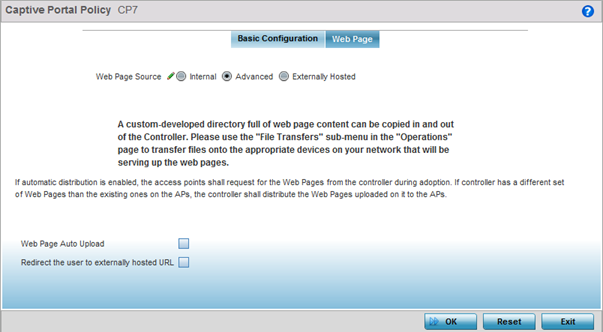
-
The access
point maintains its own set of Advanced web pages for custom
captive portal creation.
Refer to OperationsDevicesFile Transfers and use the Source and Target fields to move captive portal pages as needed to managed devices that may be displaying and hosting captive portal connections.
Select the Web Page Auto Upload check box to enable automatic upload of captive portal Web pages.
Select the Redirect the user to externally-hosted success URL check box, if the Welcome page is externally hosted.
-
Click
OK when completed to update the captive
portal's advanced configuration.
Click Reset to revert the screen back to its last saved configuration.


